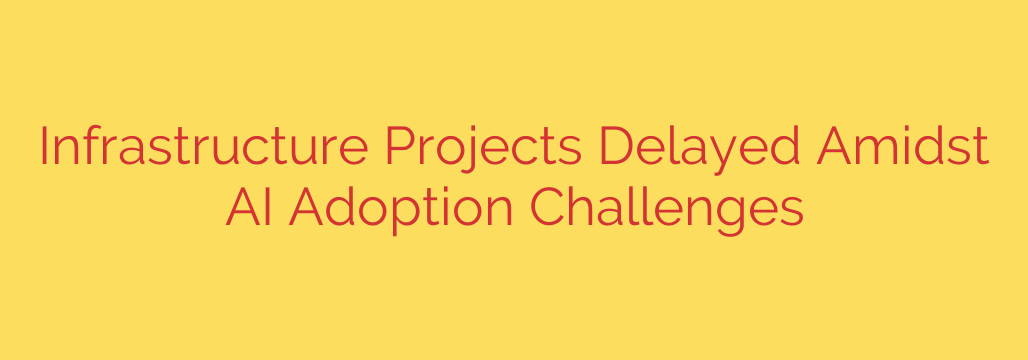
The AI Paradox: Why Is Advanced Technology Causing Infrastructure Project Delays?
Artificial intelligence was heralded as the key to unlocking unprecedented efficiency in large-scale infrastructure projects. From predictive maintenance on bridges to optimizing traffic flow in smart cities, the potential is immense. However, a troubling trend is emerging across the industry: instead of accelerating timelines, the push to adopt AI is, in many cases, causing significant and costly delays.
This paradox isn’t a sign that AI is failing; rather, it highlights the profound complexities of integrating a transformative technology into traditionally slow-moving sectors. Many organizations are discovering that the path to AI integration is fraught with unexpected obstacles that stall progress and inflate budgets. Understanding these challenges is the first step toward overcoming them and truly harnessing the power of intelligent systems.
The Core Challenges Hindering AI Adoption
The transition from legacy systems to an AI-driven framework is far from a simple plug-and-play operation. Several critical factors are contributing to these widespread delays.
The Data Integration Dilemma: AI is only as smart as the data it’s fed. Infrastructure projects rely on vast, complex datasets, from geological surveys and material specifications to decades of maintenance logs. Often, this information is stored in outdated, siloed formats that are incompatible with modern AI platforms. The immense effort required to clean, standardize, and migrate this data is frequently underestimated, creating a major bottleneck before any machine learning can even begin.
A Pervasive Skills Gap: There is a significant shortage of professionals who possess a dual expertise in both infrastructure engineering and data science. Project managers may understand construction logistics but lack the knowledge to vet an AI vendor’s algorithm. Data scientists can build powerful models but may not grasp the real-world operational constraints of a power grid or a water treatment plant. This knowledge gap leads to miscommunication, flawed implementation strategies, and tools that are ultimately unfit for their purpose.
Cybersecurity and Regulatory Hurdles: Integrating AI into critical infrastructure opens up a new frontier of security vulnerabilities. An intelligent grid or an autonomous transit system becomes a high-value target for cyberattacks. Consequently, developing robust, fail-safe security protocols is a non-negotiable but time-consuming prerequisite. Navigating the complex web of regulations governing data privacy, safety, and public works adds another layer of administrative delay that can grind projects to a halt.
Unrealistic Expectations and ROI Uncertainty: The hype surrounding AI has often led to unrealistic expectations among stakeholders and executives. Leaders may approve massive investments expecting immediate returns, only to become discouraged by the slow, iterative process of training, testing, and deploying AI models. The difficulty in proving a clear, short-term return on investment (ROI) can lead to budget cuts or a complete loss of project momentum.
A Strategic Path Forward: Tips for Successful AI Integration
Avoiding these pitfalls requires a shift from a technology-first mindset to a strategy-first approach. Organizations that successfully navigate this transition focus on building a solid foundation before deploying advanced tools.
Start with a Comprehensive Data Strategy: Before even considering AI vendors, conduct a thorough audit of your existing data infrastructure. Develop a clear roadmap for data governance, cleaning, and standardization. Invest in creating a unified data ecosystem where information is accessible and reliable. This foundational work will pay dividends by dramatically accelerating future AI initiatives.
Invest in People and Training: Bridge the skills gap by investing in cross-disciplinary training. Upskill your existing engineering teams with data literacy fundamentals and provide your data scientists with deep-dive sessions on your operational realities. Foster a culture of collaboration where both sides can learn from each other’s expertise. When hiring, look for “bilingual” talent that is comfortable in both worlds.
Adopt a ‘Security by Design’ Philosophy: Do not treat cybersecurity as an afterthought. Integrate security planning into the earliest stages of project conception. Conduct rigorous risk assessments and penetration testing specifically for AI-powered systems. Engaging with regulatory bodies early in the process can also help streamline compliance and avoid last-minute roadblocks.
Launch Pilot Programs First: Instead of attempting a full-scale AI overhaul, begin with smaller, well-defined pilot projects. Target a specific problem—like predictive maintenance for a single set of assets—and use it as a testing ground. This allows your team to learn, adapt, and demonstrate tangible value to stakeholders, building the momentum and business case needed for larger, more ambitious deployments.
Ultimately, the current delays are not an indictment of AI’s potential but a reflection of the immense preparatory work required for its successful implementation. By approaching AI adoption with a clear strategy, a focus on data quality, an investment in people, and a realistic timeline, the infrastructure sector can move past these growing pains and begin building a smarter, more efficient, and more resilient future.
Source: https://datacenternews.asia/story/major-infrastructure-projects-lag-as-ai-adoption-faces-barriers








